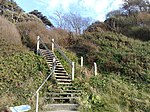HMS Pomone (1805)
1805 in England1805 ships1811 in EnglandFifth-rate frigates of the Royal NavyLeda-class frigates ... and 4 more
Maritime incidents in 1811Protected wrecks of EnglandShips built in FrindsburyShipwrecks of the Needles

HMS Pomone was a 38-gun Leda-class fifth rate of the Royal Navy launched in 1805. She saw action during the Napoleonic Wars, primarily in the Mediterranean while under the command of Captain Robert Barrie. She was wrecked off The Needles, part of the Isle of Wight, in 1811. The wreck is a Protected Wreck managed by Historic England.
Excerpt from the Wikipedia article HMS Pomone (1805) (License: CC BY-SA 3.0, Authors, Images).HMS Pomone (1805)
T25,
Geographical coordinates (GPS) Address Nearby Places Show on map
Geographical coordinates (GPS)
| Latitude | Longitude |
|---|---|
| N 50.6625 ° | E -1.5902 ° |
Address
The Needles Lighthouse
T25
PO39 0JD
England, United Kingdom
Open on Google Maps










